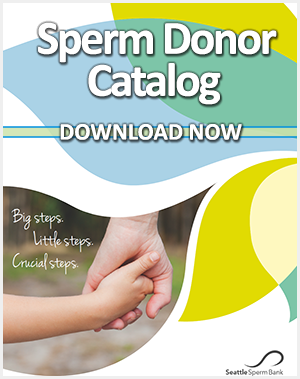When trying to conceive, understanding your ovulation cycle can be an important first step. Unless you have a known infertility issue, this awareness can help increase your chance of getting pregnant in less time.
Whatever method you use to track your fertility, each is designed to tell you the days when you’re most fertile, and therefore, the best days to attempt insemination. This is known as your “fertility window,” which includes the five days leading up to ovulation, when you have the best chance of conceiving. Knowing your window also helps when ordering your donor sperm to use for in-home insemination.
It’s important to remember that all people are different, so you’ll need to discover the method that works best for you. Plus, menstrual cycles can range from 21 to 35 days, so no single approach works for everyone. You might find that you have to try a few different methods to get it right, and that is not out of the ordinary, so don’t feel discouraged.
Here are some effective methods for tracking your fertility at home.
Calendar Method
Also known as the rhythm method, this basic approach involves tracking your menstrual cycles so you can accurately estimate your fertility window each month. This is important because this window is the only time you’ll be able to get pregnant that month. If your cycle fluctuates, it may take several months to get a reliable cycle length.
To track your cycle, pay attention to when the first day of your period occurs. This is the start of a cycle. Ovulation then occurs about 14 days later when your ovaries release an egg and your uterus lining begins to thicken. Your most fertile days will be the three days leading up to and including ovulation. If your average menstrual cycle is 28 days, you will ovulate around day 14.
Ovulation Predictor Kits (OPKs)
Ovulation predictor kits are over-the-counter tests you can purchase to help identify when you are likely to ovulate. These look like pregnancy tests and are simple to use. They are looking for luteinizing hormone (LH), a combination of LH and estrogen, or progesterone in your urine. In a typical cycle, LH increases 12 to 36 hours before ovulation. Estrogen is present right before ovulation occurs, so kits that are looking for LH and estrogen are using both hormones to identify pending ovulation.
Progesterone is present after ovulation and can help identify that ovulation successfully occurred. OPKs can range in price and not every brand or style will work for everybody. Additionally, if you have irregular cycles or are not getting clear positive indicators with OPKs, it doesn’t necessarily mean you are not ovulating, it just means these kits may not work for you.
Temperature Method
For the temperature method, you’ll need to record and chart your body temperature using a special basal thermometer, which you can get at most drug stores. Your basal body temperature, or resting body temperature, rises between .4 and 1 degree Fahrenheit when you ovulate. You may need to track your temperature for several months in a row to get an accurate reading about your ovulation patterns. This is especially true if you’re sick during that time or if your sleep patterns vary widely. Getting a good night’s sleep before you take your temperature can help you get a more accurate reading.
To find your basal body temperature, keep a digital basal thermometer next to your bed and take your temperature immediately after you wake and before you get up and begin moving. Then record your temperature this way for at least a full month. You’ll discover that your waking temperature will go up after ovulation, so you’ll know it just occurred. Mark that day of the month on your calendar and try attempting conception on that day the following month.
Because this method requires you to take your temperature daily at a specific time and can be altered by how well you slept, it can be a difficult method for tracking ovulation, and may not work for everybody.
Cervical Mucus Method
Your cervical mucus changes during throughout the month. Cervical mucus helps protect things from entering the body by creating a barrier. However, during ovulation cervical mucus changes in function to help aid in transporting sperm. About seven days after your period (this can vary from each person and vary a little each month), your cervical mucus will become noticeably clear, slick, and often white and stretchy to the touch, similar to uncooked egg whites. Ovulation generally happens within a day or two of when the mucus is at its most slippery. This is the ideal time to attempt insemination.
To use this method, you need to be familiar with your own cervical mucus and how it changes. This can vary widely from person to person and may not show clear changes around ovulation. You can check your cervical mucus by looking at your underwear or toilet paper after wiping or inserting a finger into your vagina (but always wash your hands first). If you struggle checking cervical mucus or you are not seeing the egg white stage during the month, it does not mean you are not ovulating. Cervical mucus varies, and it may not work for everyone.
We’re Here to Help
Though it can take some time to find the best fertility method for you, paying close attention to your ovulation cycle is a proven way to help you conceive faster. If you have other questions about your fertility cycle, or want other tips on trying to conceive, please contact our experts at (206) 588-1484 or via email.

